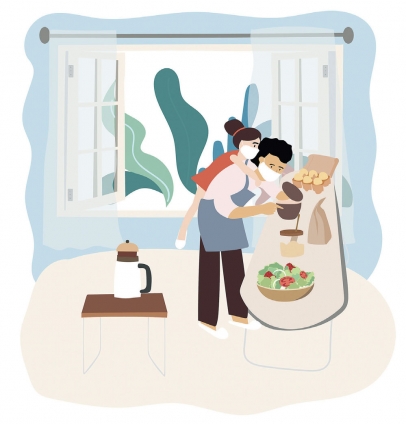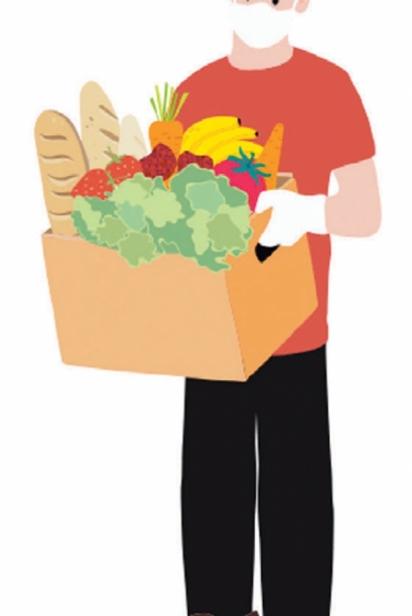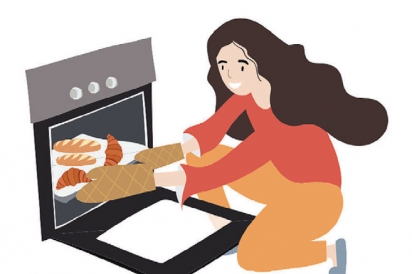Covid Cooking: Thoughts on How We’re Adapting
I don't know about you but I thought I’d be taking summer trips and inviting people over for barbecues. I was sure this would all be over by June or maybe July at the latest. I intended to see the leaves change someplace and plan a nice winter trip so we could enjoy some snow. And, of course, I had a list of new restaurants to try.
That’s all changed.
I never expected to be living the life of a hermit into November and beyond. But since I’m of a certain age and therefore at higher risk from COVID-19, that’s the reality and slowly I’ve come to adjust to what I still hope is a temporary situation.
Some adjustments were easier than others. Not seeing friends: hard. But we figured out how to visit on Zoom. Not going to the movies: easier because of my Firestick. Not being with my kids: indescribably hard, maybe the most difficult of all. Missing the gym: another really hard one even with lots of equipment at home.
Cooking three meals a day every day: Yeah, that was a tough one for me. And I love to cook. All those recipes that I downloaded from the Internet and all the hundreds (yes, hundreds) of cookbooks I own can’t make up for a meal out at one of my favorite restaurants, being served delicious food by a pleasant server and having someone else clean up!
New Shopping Habits
“Shopping” online for food is one of the most difficult adjustments I’ve had to make. Beginning in April, Sprouts and most of the other markets expanded their online ordering capabilities offering curbside pickup and delivery services. Unfortunately, some food stores like Trader Joe’s, a favorite for so many us, have not gone to online ordering. Their products change so frequently that they are unable to provide a stable online ordering process for their customers.
Not every item in the supermarket is on the online sites and oftentimes what I’m looking for doesn’t exist on the sites, or what their in-house shopper has picked out for me is mediocre at best and sometimes has to be returned because the quality is so poor. Like most shoppers, I’m not a meal planner. I used to decide what I would prepare for dinner around midday. That meant stopping at the market on my way home from wherever. Not anymore. Ordering online means planning ahead.
BC (Before COVID-19) I was accustomed to shopping for my produce at the farmers market. Many have remained open during the pandemic although they’ve had to pivot to accommodate health concerns and their clientele. Uptown Farmers Market offers curbside pickup and delivery to those who order in advance. Masks are required and physical distancing is encouraged, especially at McClendon Select’s stand where customers are asked to line up and only a few people are allowed into the space at a time to encourage distancing.
According to Bo Mostow of the Uptown Farmers Market, “We see a lot more shopping lists especially among people who have created a meal plan for the week. This is different than before COVID when we saw more impulse buying”.
Research reveals that our shopping habits don’t usually change much under normal circumstances. We shoppers have one or two stores that we frequent and we tend to buy the same items over and over. We know where everything is and, unless we have unlimited time and resources, we don’t spend much time at the market.
I admit that I used to consider it a chore to shop for food. After shopping online all these months and having people who don’t know a ripe kiwi from an overripe kiwi pick out my food for me, I’m really ready to get back to shopping for myself. In fact, right now I’d consider it an outing worthy of taking a shower and putting on clean clothes and makeup if I could go to the supermarket without risk.
Maybe, like me, you have quarantined in your homes for months now, shopping for groceries only online. Others of you may have masked up and braved the aisles. According to Sprouts, there’s been an uptick in customers consolidating trips to avoid social contact so in essence we are shopping less often than before but buying more because we are eating at home more.
Buying more. That’s a problem for me. I don’t have the space to store food, even shelf-stable food, so I’ve taken to using bookshelves in bedrooms and wherever I can find space to store cans of broth and boxes of pasta and packages of that ever-valuable commodity, toilet paper.
More Home Cooking
Cooking more at home due to COVID-19 is most certainly a trend in the United States. People like Eddie Chavez Calderon, an organizer for Arizona Jews for Justice, have been cooking more than ever. It’s not that he had never cooked before but with many restaurants shut down early in the pandemic, he had no choice but to spend more time in the kitchen.
For other people who were not working (or were working at home), cooking became a form of entertainment, especially since they now had the time to fiddle around in the kitchen. Richard Fiero, a restaurant manager, was furloughed in March. Always interested in cooking, he saw his newfound free time as an opportunity to spend more time in the kitchen. He was cooking big, involved meals for meals for his husband and for this mother five nights a week, with breaks in between to finish leftovers.
“In the beginning, I was cooking multi-course meals with freshly baked bread and homemade dessert every night. We had gourmet for the first four months, until I was exhausted,” says Fiero.
Richard and I have cooked together in my kitchen before for fun. But when we spied a delicious-looking cake on Facebook, we knew baking together was not going to be a possibility. We both follow Theresa Greco, a recipe developer who blogs as thefoodhunter, and Richard and I were both drooling over the chocolate creamsicle Bundt cake she posted. We decided to bake it “together” separately. It was at the beginning of our quarantine when outside temperatures in Phoenix were conducive to using the oven and we were into our early COVID baking mode. We each baked the cake, posted our photos and enjoyed eating it together, but apart. (See the recipe at foodhuntersguide.com/2014/04/eating-whole-foods-dark-chocolate.html).
Then there’s cooking equipment that many of us never used, or even thought about owning, now becoming more interesting to us. I wonder how many of you used your Instant Pot or air fryer for the first time over the last few months?
My friend Melinda March’s family bought themselves a pizza oven and began experimenting with all sorts of doughs and toppings for weeks. This wasn’t something they had ever done before but with everyone home, they had the time and the interest.
They also did something very clever that I probably should have done before I ended up with 10 cans of chicken broth. Melinda constructed a spreadsheet with the items they generally purchase so that they could keep track of what they had on hand and what they were running low on and what they might need to replace. Now that’s organized!
Baking Big Time
We also saw that people who don’t usually bake were baking. All that home baking created a shortage of yeast and flour. That’s when baking with sourdough starter became the thing to do. Who needs yeast when you have sourdough starter living in your refrigerator?
Sourdough starter is temperamental. It demands constant attention and using it for bread, although leading to a superior product with a lovely crust, is more labor intensive and hands on than using traditional yeast. Judging by all the articles on the subject, starter became the darling of everyone who was spending time baking bread (BTW, starter also makes great waffles, pancakes and even cupcakes).
Shirley Strembel, registered dietitian, has discovered that baking bread is an “avenue for stress reduction.” Strembel made her first loaf of sourdough back in October and once the pandemic hit, she’s been baking sourdough bread every week.
“My recipe takes several days for all the steps and the result has been better than my expectations. Every effort produces two loaves so then I have to share with friends. Delivering bread in a mask is a bit different, but the recipients are always so happy that the entire experience is uplifting and rewarding for me,” declares Strembel.
King Arthur Baking Co. reports that flour sales were up 150% from April through June of this year compared to the previous year. Strembel says she’s purchased more flour in the last five months than she has in the last 10 years.
Getting Creative
I’m not sure how we ever lived without the Internet, and especially without Google. But now more than ever if you have access to the Internet, use it for recipes, for substitution lists, to find out what store might have what you are looking for, how to order online, etc.
I doubt we’ll ever forget the empty shelves in the supermarkets or the shortages of necessities like toilet paper. We heard on the news that meat processing plants were being shut down and there might be a shortage of meat and chicken. Then, as if we needed more, there was a recall on onions. Even the meat case at Costco began to look bare for a while. Items like dried pasta and rice, flour and yeast were as hard to find as toilet paper.
Short supplies of some ingredients and outrageous prices online for those that were out of stock in the stores sent people scrambling to find substitutes. What if a recipe requires baking soda for leavening, but you’re out of it and so is the market?
Or your recipe calls for buttermilk but you can’t make a quick trip to the supermarket to get just one item? Ingredient substitution lists like allrecipes.com/article/common-ingredient-substitutions are absolutely essential now.
For those of us lucky enough to have access to a garden, even if the garden is a container one on a balcony, it can pay off big time to learn a little about salvaging cuttings from fruits and vegetables so you can easily grow your own. For years, I’ve been replanting the root end of scallions. It takes a while to “harvest” a new scallion, but it means I’ve always got them. If you use lemongrass but only infrequently, so it’s not something you always have in your refrigerator, I’ve had great success taking even what looked like a dried-out old stalk from the supermarket, sticking it in a glass with some water until I see some roots and then planting it. Lemongrass is one of those plants that has lots of “babies,” so I always have plenty of lemongrass. For more ideas like this, check out apieceofrainbow.com/veggetables-herbs-regrow-kitchen-scraps.
Cooking for one or two can sometimes be daunting because it means either lots of leftovers (to freeze and eat again!) or wasted ingredients. What if the market sends a big avocado with your order? You know it will turn brown after you cut it even if you try to store it rubbed with some lime. Did you know you can freeze a cut avocado? It will be very soft after defrosting so it’s not good for recipes where you might need a sliced avocado that holds its shape but since it won’t oxidize while frozen it can be used for any mashed recipe like your avocado toast or guacamole or incorporating into a salad dressing as the fat alternative.
Will Our Increased Interest in Cooking Last?
My friend Helen Goldman says she started cooking nice meals at the beginning but now she’s making scrambled eggs, grilled cheese sandwiches and going through the fast-food drive. Even Donna Nordin, Tucson cooking teacher and former chef and restaurateur, says she’s “close to being sick of cooking.”
However, whereas I once shopped daily for our needs and never used the freezer except for ice cubes, I now store cooked leftovers alongside raw meats, fish and chicken (and don’t forget those avocado halves). Whereas I once ran in and out of the supermarket as quickly as possible, I now dream of a long leisurely trip there, walking up and down every aisle (in whatever direction I choose), smiling (mask-less) at others passing me closer than six feet, my cart laden with food.









